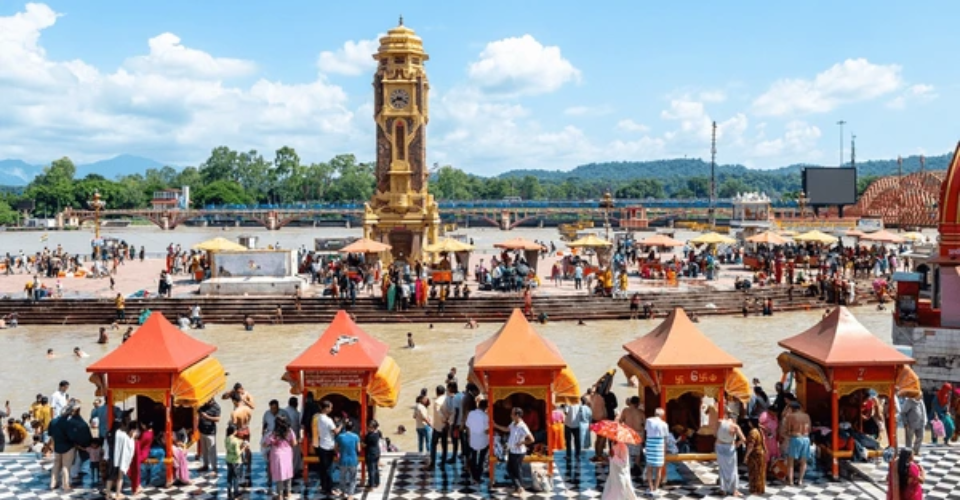
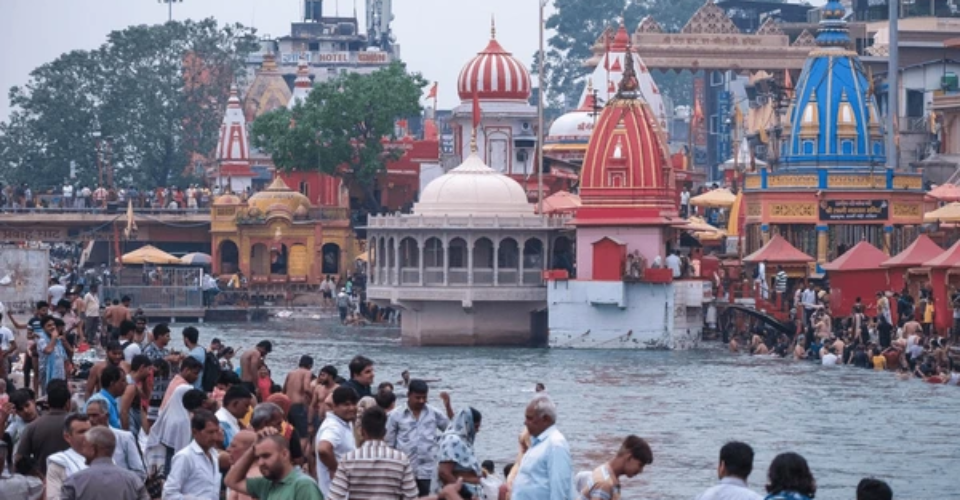
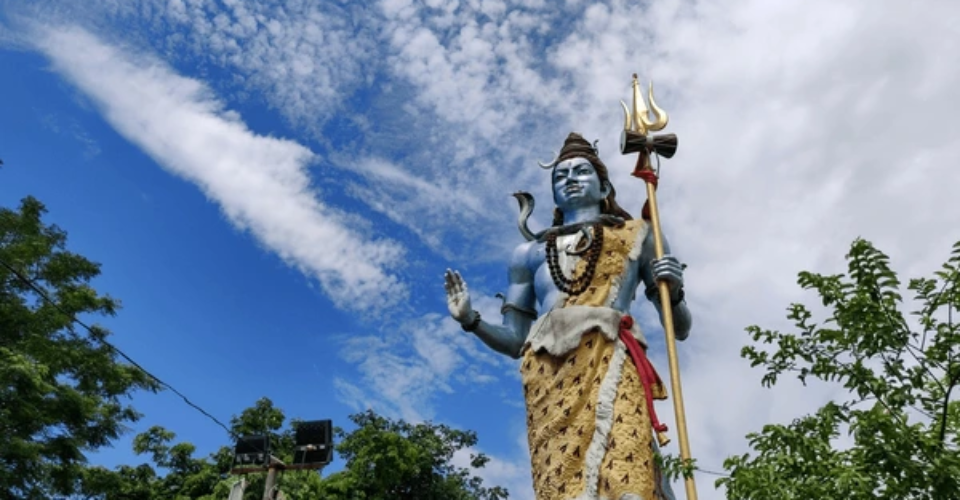
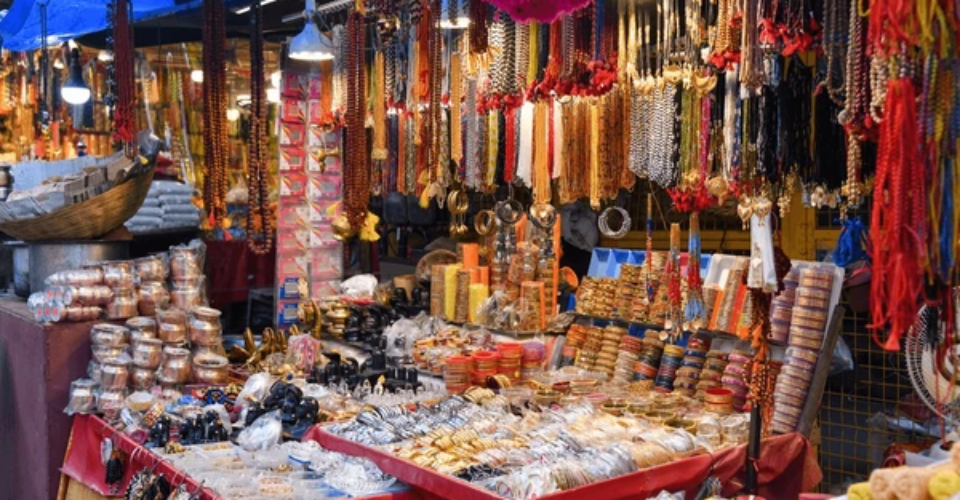
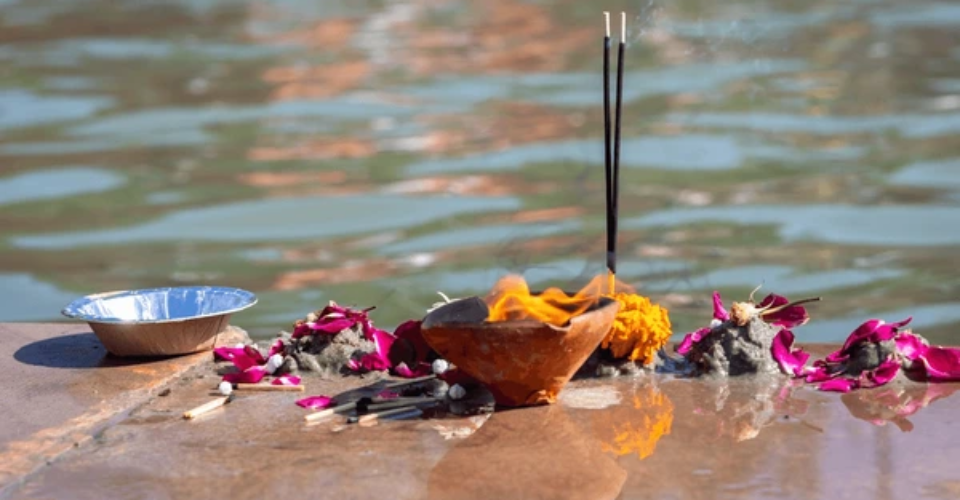


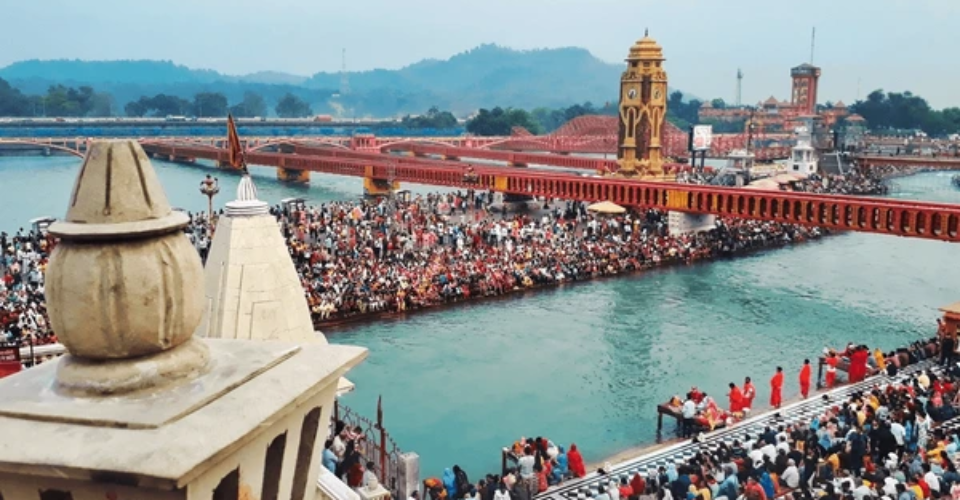
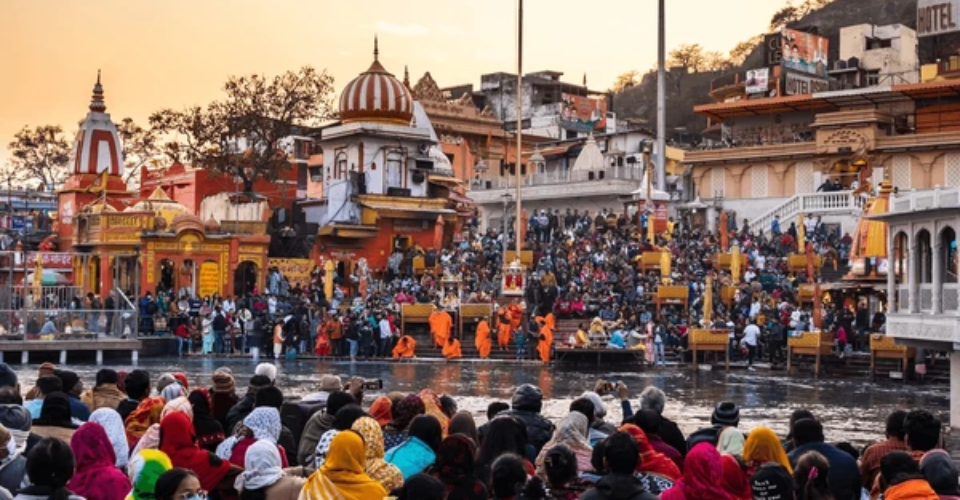

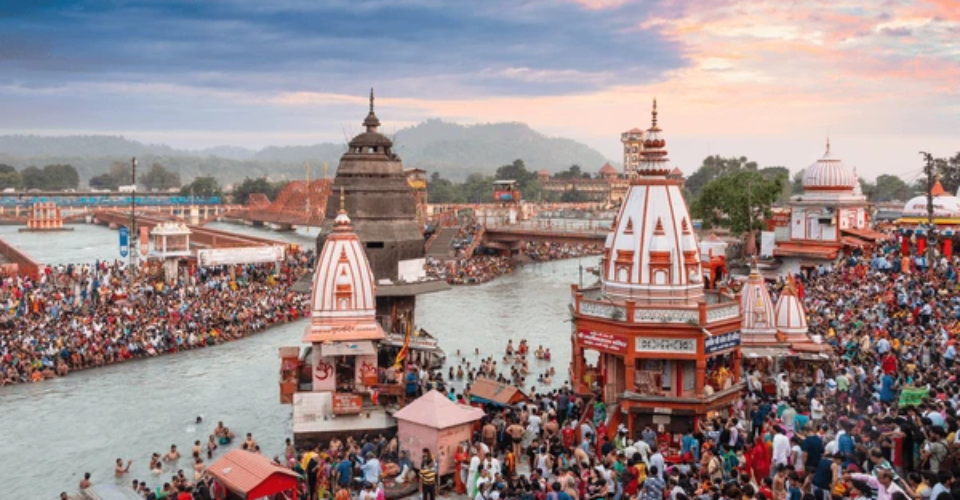

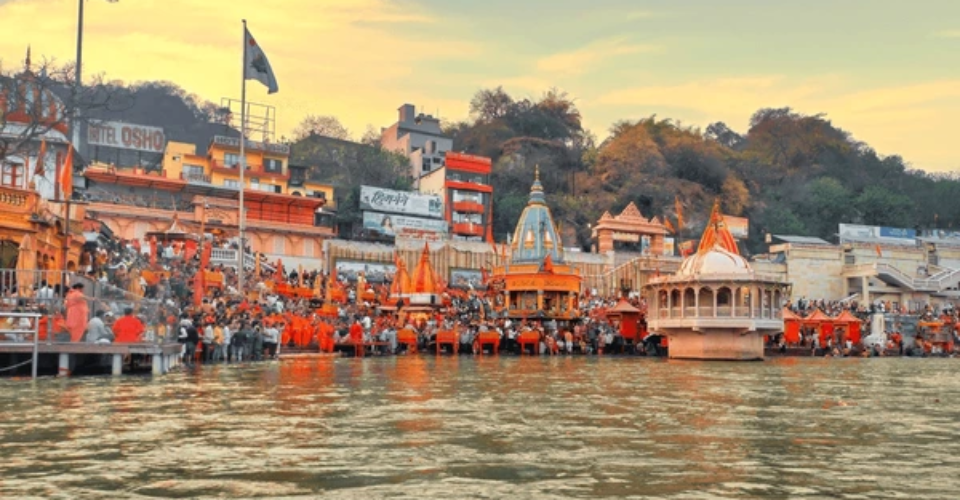

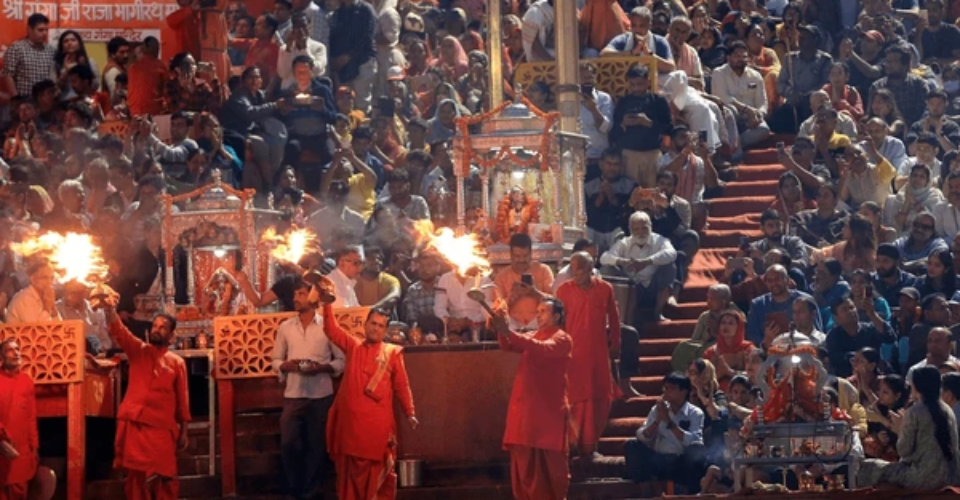

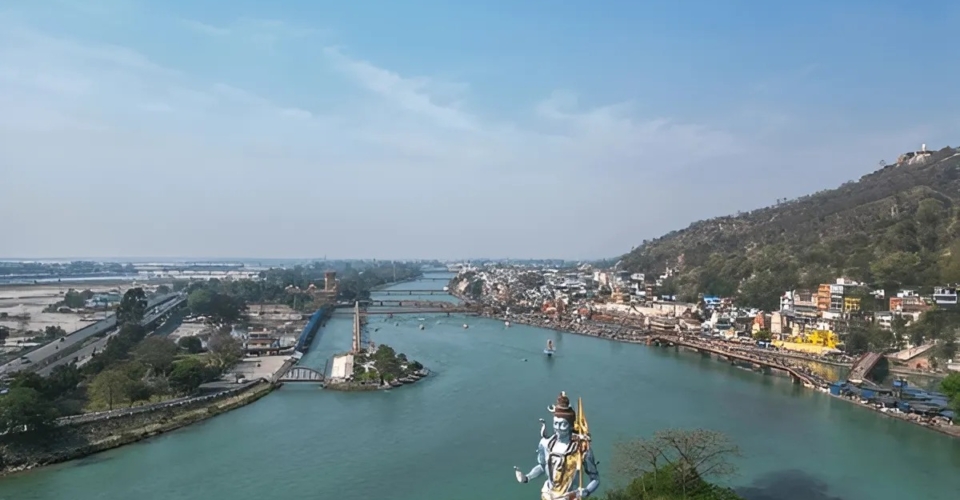

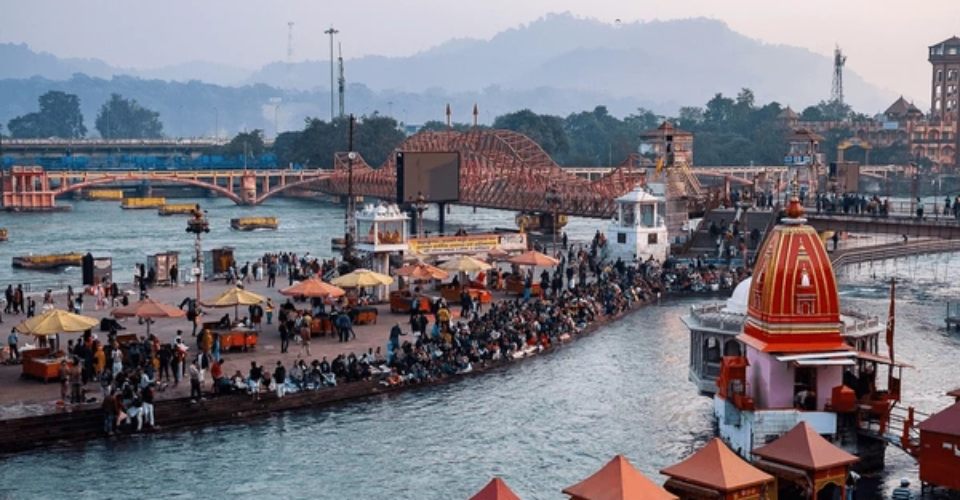




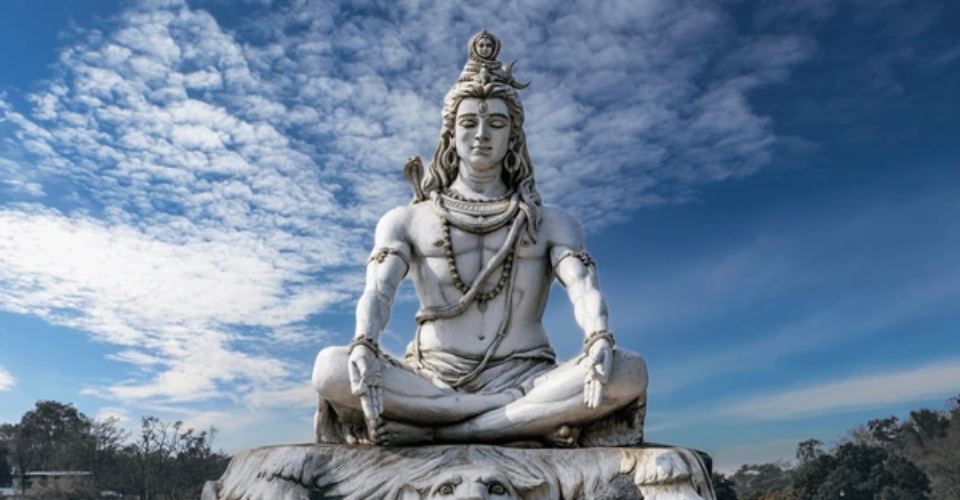
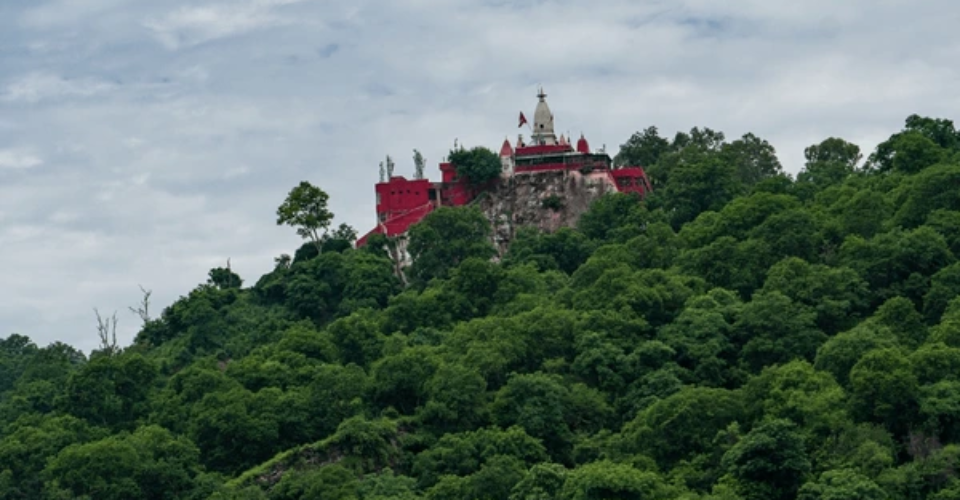
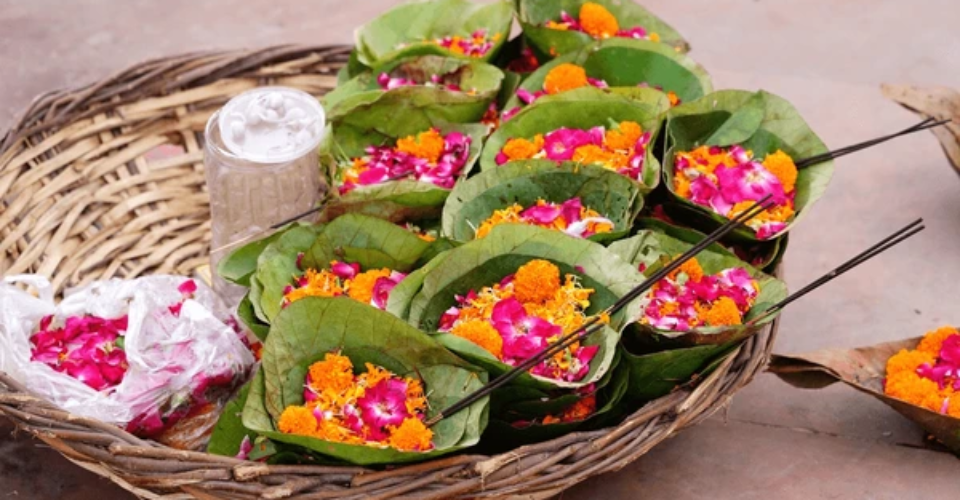
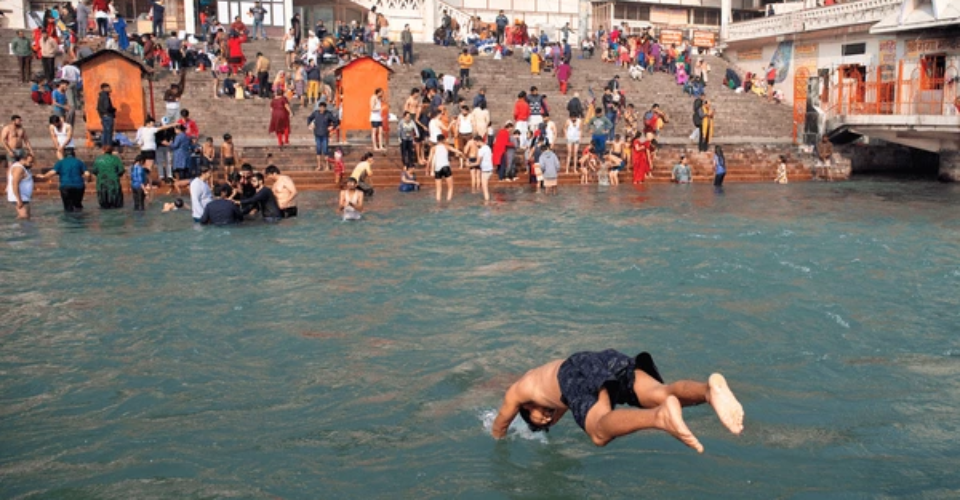
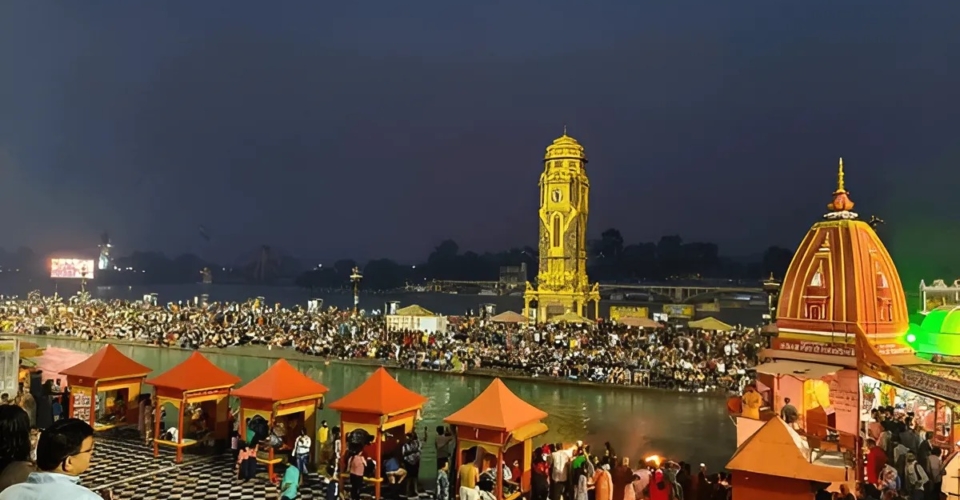
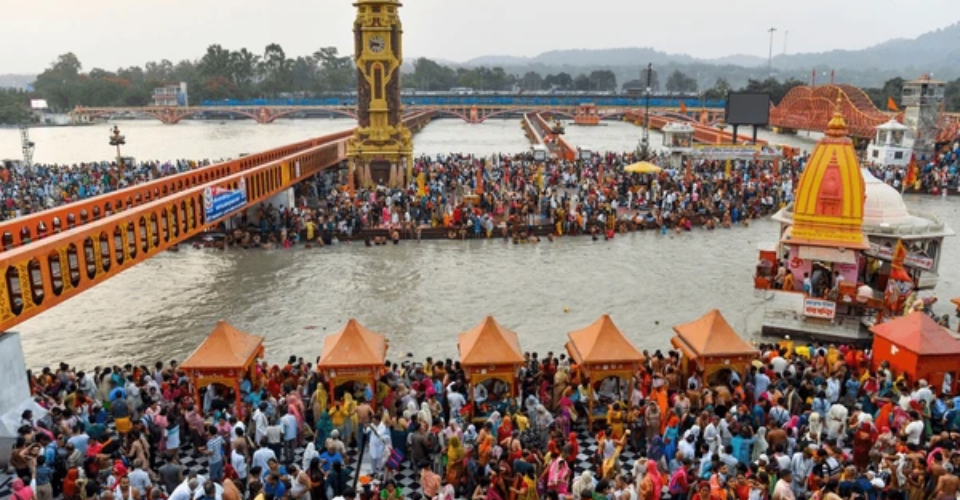


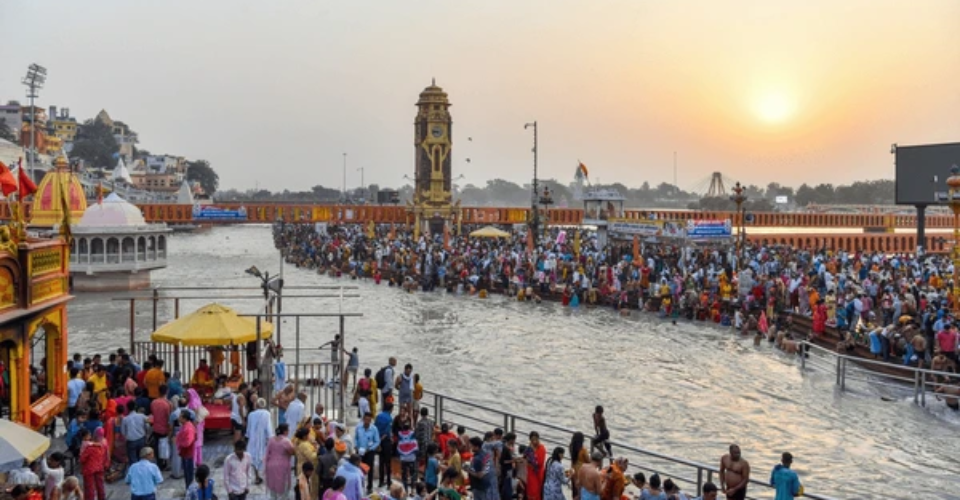

Haridwar, located in the Indian state of Uttarakhand, is a spiritually significant city where the Ganga River first enters the plains after its descent from the Himalayas. Known as one of Hinduism’s seven holiest places, Haridwar has welcomed pilgrims for centuries and remains a powerful symbol of devotion, tradition, and sacred ritual.
Thousands visit every day to take a ritual bath in the Ganga, believed to purify the soul and absolve one of sins. It’s not just a destination, but a starting point of spiritual journeys. The name Haridwar is derived from “Hari” (God) and “Dwar” (gateway), which together translate to the “Gateway to the Divine.”
Haridwar isn’t just known for its sacred river — it’s a place where spirituality comes alive. The city is rich in ancient temples, time-honored rituals, and the vibrant life of sadhus and pilgrims. From the powerful chanting of mantras to the evening Ganga Aarti at Har Ki Pauri, the city offers a deeply moving cultural and religious experience.
The city is also seen as the entry point to the Char Dham Yatra — the sacred pilgrimage to Yamunotri, Gangotri, Kedarnath, and Badrinath, making it a must-visit for devotees before they begin their journey to the Himalayan shrines.
Beyond its religious importance, Haridwar is blessed with scenic beauty. Surrounded by forested hills and flowing rivers, the city is a peaceful escape with a spiritual charm. In the evenings, the riverfront transforms into a glowing spectacle of floating lamps and prayers.
Close by is Rajaji National Park (just 10 km away), home to elephants, tigers, and a wide variety of birds, offering a dose of wildlife and eco-tourism for nature lovers and adventure seekers.
Haridwar is made up of several distinct areas like Jwalapur, Mayapur, Devpura, Har Ki Pauri, Motichur, Ranipur, and Shivalik Nagar, each adding to its diverse character. It is also one of four sites where the Kumbh Mela, the largest religious gathering on Earth, is held every 12 years, and Ardh Kumbh every 6 years — attracting millions of devotees from around the world.
It is believed that drops of Amrit (nectar of immortality) from the mythical ocean-churning fell here, blessing the city with divine energy. This mythological significance has helped shape Haridwar’s spiritual reputation through generations.
Haridwar, one of the seven holiest places (Sapta Puri) in Hinduism, holds a deeply sacred place in Indian spiritual tradition. The name “Haridwar” is derived from two words: Hari (a name of Lord Vishnu) and Dwar (door or gateway), meaning “Gateway to Lord Vishnu.” It is also called “Hardwar,” meaning “Gateway to Lord Shiva” (Har meaning Shiva), depending on the devotee’s tradition.
According to Hindu mythology, Haridwar is one of the four sites where drops of Amrit (the elixir of immortality) fell from the Kumbha (pot) carried by the celestial bird Garuda during the churning of the ocean (Samudra Manthan). This event is commemorated every 12 years in the Kumbh Mela, a major religious gathering that draws millions.
Haridwar finds mention in several ancient texts and scriptures. The Mahabharata and Ramayana refer to the city as a pilgrimage site. It was known by various names over time, such as Kapilsthan, referring to the sage Kapila, who is said to have meditated here.
The city was also part of the Maurya Empire and later the Kushan Empire. Archaeological evidence shows the region has been inhabited since at least the 3rd century BCE.
During the medieval period, Haridwar attracted saints, scholars, and travelers from around the world. The famous Chinese traveler Xuanzang (Hiuen Tsang) visited the region in the 7th century and noted it as a prosperous and spiritually vibrant place.
In the 16th century, Mughals showed interest in the region. Emperor Akbar is known to have encouraged Hindu pilgrimages and helped restore certain facilities in the area. The city was also referenced in the writings of several Mughal historians.
Under British rule in the 19th century, Haridwar became part of the United Provinces (now Uttarakhand). The British developed infrastructure to support the massive influx of pilgrims, including building canals, ghats, and roads. The Ganga Canal, constructed by Proby Cautley in 1854, is a major engineering feat of that era and is still in use today.
In 1868, the Haridwar Municipality was officially established. The British also promoted Haridwar as a site of spiritual tourism.
After India gained independence in 1947, Haridwar continued to grow in religious and cultural significance. In 1966, Gurukul Kangri University was established, reviving Vedic studies in the traditional Gurukul system. The city became part of Uttarakhand state in 2000, when it was carved out of Uttar Pradesh.
In recent decades, Haridwar has seen significant development in infrastructure and tourism. It remains a vital religious destination, drawing millions of devotees for Ganga Aarti at Har Ki Pauri, ritual bathing in the Ganges River, and spiritual festivals like Kanwar Yatra and Kumbh Mela.
Haridwar, a revered pilgrimage city in the Indian state of Uttarakhand, experiences a subtropical climate marked by three distinct seasons: summer, monsoon, and winter. Situated at the foothills of the Himalayas and along the banks of the holy River Ganga, Haridwar’s weather plays a significant role in the rhythm of daily life and religious activities.
Summers in Haridwar can be hot and dry, especially during May and June, which are the hottest months. The days are long and sunny, but mornings and evenings can still be relatively pleasant due to the proximity of the hills. Despite the heat, this is a popular time for pilgrims visiting the Ganga and attending festivals like Ganga Dussehra.
The monsoon season brings moderate to heavy rainfall to Haridwar, transforming the landscape into a lush green environment. The Ganga swells with rainwater, adding to the spiritual ambience. However, travel plans can be affected due to occasional flooding or waterlogging in some areas.
Winters in Haridwar are cool and comfortable, with December and January being the coldest months. Mornings and evenings can be quite chilly, especially near the river. This season is ideal for sightseeing and spiritual activities, including the Kumbh Mela (when it occurs) and Makar Sankranti celebrations.
How to Reach Haridwar: Your Complete Travel Guide
Haridwar, one of the seven holiest cities in India, is a prominent pilgrimage destination located in the state of Uttarakhand. Nestled on the banks of the sacred Ganga River, it attracts millions of devotees and tourists every year. Here’s how you can reach Haridwar:
The nearest airport to Haridwar is Jolly Grant Airport (DED) in Dehradun, which is approximately 37 km away.
Haridwar Junction (Station Code: HW) is a major railway station with excellent connectivity across India.
Haridwar has well-maintained road connections with key cities in North India.
a. From Delhi (Approx. 220 km)
b. From Dehradun (Approx. 55 km)
c. From Rishikesh (Approx. 20 km)
You can also book private taxis or use ride-sharing services like Ola and Uber (availability may vary based on the region). This is a convenient option for those traveling with family or in groups.
Haridwar, one of the seven holiest places (Sapta Puri) in Hinduism, is located on the banks of the sacred river Ganga in Uttarakhand, India. It is a prominent pilgrimage site where devotees perform various religious rituals and pujas for spiritual growth, blessings, and liberation of ancestors. Here is a comprehensive list and explanation of the popular pujas offered in Haridwar:
Haridwar, one of the seven holiest places in Hinduism, is a vibrant city located in the Indian state of Uttarakhand. Besides its spiritual and cultural significance, Haridwar offers a wide range of facilities catering to residents, pilgrims, and tourists.
Haridwar is well-connected by various modes of transport:
Haridwar has a wide range of accommodation options:
Haridwar offers various medical services and hospitals:
As a major pilgrimage site, Haridwar offers:
Haridwar is home to several educational institutions:
Haridwar, located on the banks of the sacred River Ganges, is one of the seven holiest places in Hinduism. This ancient city is a gateway to the Char Dham pilgrimage (Yamunotri, Gangotri, Kedarnath, and Badrinath) and is renowned for its spiritual ambiance, ancient temples, and vibrant festivals. Here are some of the top attractions in Haridwar:
Nestled on the banks of the holy Ganges River in Uttarakhand, Haridwar is one of India’s most spiritually vibrant destinations. Known for its ghats, temples, and the evening Ganga Aarti, it attracts pilgrims and travelers from all over the world. Whether you’re visiting for religious reasons or just to experience the culture, here are 10 essential tips to make your trip smooth, safe, and memorable.
1. Respect Local Customs and Dress Modestly
Haridwar is a deeply spiritual city, so modest attire is appreciated, especially when visiting temples or attending religious ceremonies. Light, comfortable clothing that covers shoulders and knees is ideal.
2. Attend the Ganga Aarti at Har Ki Pauri
Don’t miss the Ganga Aarti, held every evening at Har Ki Pauri. It’s a breathtaking spiritual experience with priests chanting, lamps floating on the river, and a gathering of hundreds of devotees. Arrive early to get a good spot.
3. Try Local Street Food, but Be Cautious
Haridwar offers delicious vegetarian street food like kachoris, aloo puri, jalebis, and lassi. While tasty, opt for clean, busy stalls and carry hand sanitizer or wet wipes.
4. Stay in an Ashram for a Unique Experience
For a more immersive stay, consider staying in a local ashram. Many offer clean accommodations, simple meals, and spiritual programs like yoga or meditation.
5. Keep Cash Handy
While digital payments are increasingly accepted, many local shops, eateries, and rickshaw drivers prefer cash. Carry small denominations for convenience.
6. Avoid Bathing Alone in the Ganges
While bathing in the Ganga is a ritual for many, be cautious. The current can be strong. Use designated bathing areas and avoid going too deep, especially if you’re not a strong swimmer.
7. Be Prepared for Crowds During Festivals
Haridwar gets extremely crowded during Kumbh Mela, Kanwar Yatra, and major Hindu festivals. Plan your trip accordingly, book your accommodation well in advance, and be mentally prepared for large crowds and traffic.
8. Footwear Etiquette
Always remove your shoes before entering temples or religious spaces. It’s a sign of respect. Most places have designated racks for shoes—carry a small bag if you want to keep them with you.
9. Use Local Transport Wisely
Cycle rickshaws, autos, and e-rickshaws are common, but negotiate the fare beforehand if it’s not metered. For nearby attractions, consider booking a day taxi or using local buses.
10. Stay Hydrated and Protect Yourself from the Sun
Haridwar can get hot, especially in summer. Carry a water bottle, wear a hat or scarf, and use sunscreen. Refill your bottle at safe drinking water spots or buy sealed mineral water.
Haridwar, nestled in the foothills of the Himalayas in Uttarakhand, India, is one of the most sacred and ancient cities in the country. A spiritual magnet for millions, it is steeped in mythology, tradition, and natural beauty. Here are ten fascinating facts that make Haridwar a must-visit destination and a place of deep reverence:
1. Gateway to the Gods
The name Haridwar translates to “Gateway to God” (Hari means God, and Dwar means gate). It is one of the seven holiest places (Sapta Puri) in Hinduism and serves as the entry point to the four major pilgrimages of Uttarakhand—Char Dham: Badrinath, Kedarnath, Gangotri, and Yamunotri.
2. The Ganges Enters the Plains Here
Haridwar is the place where the sacred River Ganga emerges from the Himalayas and enters the northern plains of India. The river’s entry into the plains here marks an important milestone and is considered highly auspicious by Hindus.
3. Home to the Grand Ganga Aarti
Each evening at Har Ki Pauri, the Ganga Aarti ceremony takes place—a spiritual spectacle of chanting, fire lamps, and devotion. Thousands of pilgrims gather on the ghats to witness the ritual and offer floating diyas (lamps) into the river, creating a mesmerizing view.
4. One of the Four Kumbh Mela Sites
Haridwar is one of the four cities where the Kumbh Mela, the world’s largest religious gathering, is held every 12 years. During this time, millions of devotees come to take a holy dip in the Ganges to cleanse their sins and attain salvation.
5. Mythological Significance
According to Hindu mythology, Haridwar is one of the places where drops of amrit (nectar of immortality) fell from the celestial Kumbh (pot) carried by the divine bird Garuda. This mythological event is the foundation of the Kumbh Mela.
6. Ancient Temples and Ashrams
Haridwar is home to several ancient temples and ashrams that have stood the test of time. Notable ones include Mansa Devi Temple, Chandi Devi Temple, and the Maya Devi Temple, which is considered a Shakti Peeth—a divine place of cosmic power.
7. A Hub for Yoga and Ayurveda
Along with neighboring Rishikesh, Haridwar is a global hub for yoga, meditation, and Ayurveda. Numerous ashrams and wellness centers offer spiritual and holistic retreats attracting seekers from around the world.
8. Cultural Melting Pot
Haridwar is not just a religious city; it is a vibrant confluence of cultures, festivals, and rituals. The city buzzes with fairs, local arts, traditional music, and vegetarian cuisine that reflects the sanctity of the place.
9. Environmental and Ecological Significance
The Ganges River at Haridwar supports a rich ecosystem and has been the focus of multiple environmental initiatives. The city is also close to the Rajaji National Park, which offers a haven for wildlife including elephants, tigers, and leopards.
10. Pilgrimage All Year Round
Unlike many seasonal pilgrimage spots, Haridwar remains a spiritual hotspot throughout the year. Festivals like Kanwar Yatra, Diwali, Holi, and Makar Sankranti attract devotees continuously, making it a city that never sleeps spiritually.
